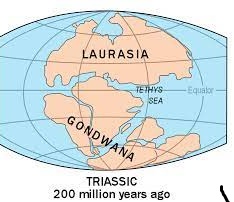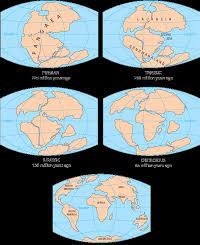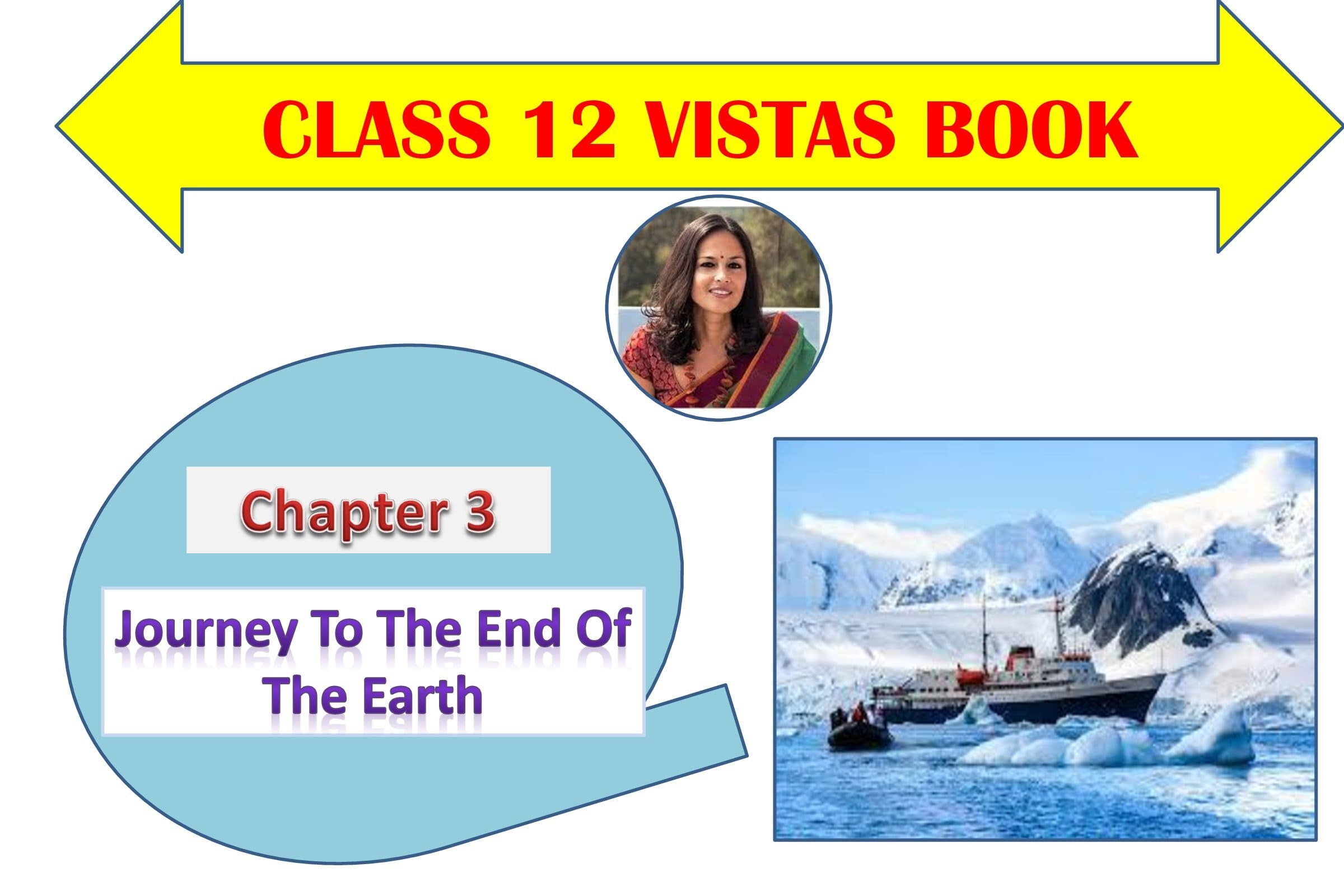Journey to the End of the Earth Summary, explanation, and question answers for Chapter 3, “Journey to the End of the Earth” from the CBSE Class 12 English Vistas book
Explore the content of Lesson 3, “Journey to the End of the Earth,” from the CBSE Class 12 English Vistas book. The comprehensive package includes a summary, detailed explanations of the lesson, elucidation of challenging vocabulary, and a subsequent summary of the entire lesson. Additionally, the material encompasses all exercises and questions related to “Journey to the End of the Earth” found at the end of the lesson.
Journey to the end of the Earth Class 12 Vistas by – Tishani Doshi

What is Travelogue ?
A travelogue is a narrative or account of a person’s journey or experiences during their travels. It often includes details about the places visited, the people encountered, and the observations made along the way. Travelogues can take various forms, including written narratives, books, blogs, or even multimedia presentations, and they aim to share the traveller’s perspective and insights about different locations and cultures.
Journey to the End of the Earth Theme
Journey to the end of the Earth is about the author Tishani Doshi’s journey to Antarctica. The theme of the chapter revolves around exploration, the beauty of nature, and the impact of human activities on the environment. Doshi reflects on the pristine and fragile ecosystem of Antarctica, drawing attention to the need for conservation and environmental awareness. The chapter explores the idea of the journey as both a physical expedition and a metaphor for self-discovery and understanding our connection to the planet.
Journey to the end of the Earth Summary
Earlier this year, I was on a Russian research ship called the Akademik Shokalskiy, heading to Antarctica. My trip started in Madras, 13.09 degrees north of the Equator. During the journey, we crossed nine time zones, went through six checkpoints, crossed three bodies of water, and passed through various ecosystems.
When I finally stepped onto Antarctica, I had been traveling for more than 100 hours by car, airplane, and ship. So, my first feeling when I saw Antarctica’s huge white land and endless blue sky was relief. After that, I felt an immediate and deep sense of wonder. I was amazed by how vast and isolated Antarctica is. I couldn’t believe that there was a time when India and Antarctica were connected as part of the same land.
A very long time ago, about 650 million years back, there was a big combined southern supercontinent called Gondwana. It was mostly centered around what’s now Antarctica. Back then, things were really different. Humans didn’t exist yet, and the weather was much warmer, with lots of different plants and animals. Gondwana lasted for about 500 million years. But later, around the time when the dinosaurs disappeared, and the age of mammals started, this landmass broke apart into different countries, shaping the Earth like we see it today.
Part Of History –

Going to Antarctica now means being a part of its history and understanding where we’ve come from and where we might be going. It’s about getting why things like Cordilleran folds and pre-Cambrian granite shields, ozone, carbon, evolution, and extinction are important. When you think about all that can happen in a million years, it can be pretty mind-boggling. Just imagine: India moving north and pushing against Asia to make the Himalayas, or South America drifting away to join North America. This created the Drake Passage, making a cold current that keeps Antarctica icy, isolated, and at the bottom of the world.
As a person from sunny South India, spending two weeks in a place where 90% of the Earth’s ice is stored is not very comforting. It’s not just cold for the body, but also for the imagination. It feels like entering a huge empty space, like a giant ping-pong ball with no signs of human life—no trees, billboards, or buildings. In this place, you lose your sense of how big things are and what time it is. You can see things that are super tiny, like midges and mites, and also huge things like blue whales and icebergs as big as countries (some as big as Belgium).
The days just keep going in this weird 24-hour sunlight during the southern summer, and it’s really quiet except for sometimes when there’s an avalanche or a big chunk of ice breaks off. It feels like a special and quiet place that makes you think about the history of the Earth. Sadly, the future doesn’t look so good for humans here.

Human Impact-
People have been around for just 12,000 years, which is like a tiny moment on a big clock of Earth’s history. In this short time, we’ve made a lot of noise, showing that we’re in charge by building villages, towns, cities, and even megacities. But because there are so many of us, we’re now competing with other animals for things we need. Also, burning a lot of fossil fuels has made a thick blanket of carbon dioxide around the world. This blanket is making the Earth warmer bit by bit.
People are arguing a lot about climate change nowadays. They wonder if the huge West Antarctic ice sheet will melt completely, or if the Gulf Stream ocean current will get messed up. Some even worry if it’s going to be the end of the world as we know it. Well, who knows? But one thing for sure is that Antarctica is really important in this debate. It’s not just because it’s a place where no humans live, keeping it pretty clean. The big deal is that it has really old carbon records trapped in its ice, like a history book of the Earth for the past half-million years. If we want to learn about how the Earth was in the past, how it is now, and what might happen in the future, Antarctica is the place to check out.
I was part of a program called Students on Ice while on the Shokalskiy ship. This program’s goal is to take high school students to far-off places and give them exciting learning opportunities. The aim is to help them develop a new understanding and respect for our planet. The program has been running for six years and is led by a Canadian named Geoff Green. He started this program because he was tired of taking famous people and retired individuals who could only contribute in limited ways.
With Students on Ice, he wants to provide a life-changing experience to the future leaders of our world, giving them the chance to absorb, learn, and most importantly, take action.The program works really well because it’s impossible not to be influenced when you visit the South Pole. It’s simple to be indifferent or unconcerned about polar ice melting when you’re in your comfy home, but when you witness glaciers shrinking and ice shelves falling apart, you start understanding that global warming is a genuine and serious threat.
Antarctica is a great place to study how small changes in the environment can cause big effects because of its simple ecosystem and limited biodiversity. For example, there are tiny plants called phytoplankton in the ocean that play a crucial role in the Southern Ocean’s food chain. These small plants use the sun’s energy to make food through a process called photosynthesis. Scientists warn that if the ozone layer continues to deplete, it could impact the activities of phytoplankton, affecting the lives of all the marine animals and birds in the region, as well as the global carbon cycle. The story of phytoplankton teaches us a valuable lesson: taking care of small things can have a big impact on everything else.
Walk on the Ocean –
During my time in Antarctica, I had many moments of realization, but one of the best happened just before reaching the Antarctic Circle at 65.55 degrees south. Our ship, the Shokalskiy, got stuck in thick ice, and we couldn’t go any further. The Captain decided to turn around, but before we did, all 52 of us were told to climb down and walk on the ocean. Wearing special gear, we walked on a vast expanse of white ice. Beneath the ice was a meter-thick layer, and below that, 180 meters of living saltwater. In the distance, Crabeater seals were lounging on ice floes. It was an amazing realization: everything is connected.
After crossing nine time zones, six checkpoints, three bodies of water, and various ecosystems, I couldn’t help but marvel at the delicate balance on our planet. I wondered how things would change if Antarctica became as warm as it used to be. Would we still be here to witness it, or would we have disappeared like dinosaurs, mammoths, and woolly rhinos? It’s hard to predict. However, spending two weeks with a group of idealistic teenagers who want to save the world made me realize that a lot can happen over a million years, but even a single day can make a significant difference!
Question Answers –
Short Questions Answers-
Q.1. What was Academic Shokalsky? Where was it headed and why?
A.1. The Academic Shokalsky was a Russian research vessel headed to the Antartica, the coldest driest and windiest continent of the world. It was committed to providing inspiring educational opportunities to the students so that they could gain anew understanding of and respect for the planet as a part of the programme called “Students On Ice.”
Q.2 What was Gondawana? For how long and where did it exist?
A.2 Gondawana was the name of the giant, amalgamated, southern super continent centered around the present day Antartica which existed about 650 million years ago. The warmer climate posted a variety of flora and fauna and the landmark thrive3d for 500 million.
Q.3 Why does the author feel that being in the Antartica is like being in a giant ping-pong ball?
A.3 the author felt so because like a giant ping-pong bal, it was devoid of any human markers like trees, billboards and buildings. He lost all sense of earthly perspective and days seem to go on endlessly. The silence was interrupted only while the sound of an avalanche or calving of ice sheet.
Q.4 What was one of the hotly contested and environmental debate of our time? Why is Antartica a crucial element in the debate?
A.4 Climate change is what features in most environmental debates. The Antartica is the only place in the world that has never sustained human population and is pure in this respect but more importantly because it holds in its ice core. Half a million year old carbon records trapped in layers of ice.
Q.5 How does the writer get across the message that one has t take care of small things and big things will fall into place?
A.5 The phytoplanktons which sustains the entire southern ocean’s food chain uses sun’s energy for photosynthesis and a further depletion in the ozone layer could affect the activities which in turn would adversely affect the lives of all th marine animals, birds of the region and the global carbon cycle.
Q.6 What are the indications for the future of humankind?
A.6 The rapid human population growth and limited resources exert pressure on land. Melting of ice-caps, depletion of ozone layer and global warming are the real immediate dangers for mankind.
Q.7 What is the aim of Geoff Green’s program ‘Students on Ice’ ?
A.7-The aim of the “Students on Ice” program is to provide high school students with inspiring educational opportunities by taking them to different ends of the world, including places like Antarctica. The program seeks to foster a new understanding and respect for the planet among young minds. It offers life-changing experiences to students, allowing them to absorb, learn, and take action for the benefit of the environment. “Students on Ice” focuses on exposing the future generation of policy-makers to diverse environments, encouraging them to engage with and contribute positively to the world.
Long Questions Answers-
Q.1 Why is Antartica the place to go to understand the earth’s present, past and future?
A.1 The Antartica is the only place on the earth that has never sustained a human population. And in this respect it remains untouched, pure and unhampered and therefore remains relatively pristine in this respect. In this frozen ice core are buried half a million year old carbon records trapped in its layers of ice. If we are desirous of learning about the pat, the present and the future, the Antartica is the only place to go to.
Q.2 The world’s geological history is trapped in Antartica. How is the study f this region useful to us?
A.2 The study of this region is useful as it gives us an insight into how the earth forms continents as they are today came into being. It gives us an understanding about the formation and significance of cordilleran folds and pre-Cambrian granite shields, about carbon and ozone and the animals thrived at a certain time in history and why they became extinct. It throws light on why certain species evolved and where we are heading with the life styles that we adopted. There are lessons to be learnt from half a million years of secrets and carbon records buried I th frozen ice core of Antartica. It tells us that 650 milllion years ago the giant amalgamated supercontinent Gondwana did exist but at the time that the dinosaurs began to get extinct and around the time that human beings came into existence, the landmass separated into continents.
Q.3 “And for the few months, the prognosis is not good.” In what context and on what basis does the author make this observation?
A.3 Doshi is of the opinion that though the human race has been around only for a mere 12000 years we have already managed to create as situation that can have the most disastrous consequences on the future health of the planet an its ability to sustain human life. The Antartica is a centre of all climate change debates as it is the only place in the world that has ever sustained a human population and is therefore pure and holds in its ice-cores half a million year old carbon records. Its ecosystem is simple and is the prefect place to study how little changes in the environment can have big repercussions. Any depletion in the ocean’s food chain adversely affects the lives of all marine animals, birds and carbon cycle. The threat of global warming becomes a reality when one sees retreating dice-shelves collapsing.
Q4. What are Geoff Green’s reasons for including high school students in the Students on Ice expedition ?
A.4- Geoff Green, the founder of Students on Ice, has several reasons for including high school students in the expedition. Some reasons are given below:
Educational Opportunity:
Geoff Green believes that the polar regions offer a unique and powerful educational opportunity. Experiencing the Arctic or Antarctic firsthand allows students to witness the impacts of climate change, gain a deeper understanding of polar ecosystems, and engage with scientific research.
Inspiration and Empowerment:
Green aims to inspire and empower young people by exposing them to the wonders of the polar regions. Through direct experience, students can develop a strong connection with the environment and become advocates for environmental conservation and sustainability.
Future Leaders in Environmental Stewardship:
By involving high school students, Green is investing in the development of future leaders in environmental stewardship. The hope is that these students, having witnessed the effects of climate change and learned about the importance of environmental preservation, will take on active roles in addressing global environmental challenges.
Global Perspective:
The Students on Ice expedition provides students with a global perspective on climate change and environmental issues. By interacting with peers from around the world, students can gain insights into the varied impacts of climate change and collaborate on potential solutions.
Hands-On Learning:
Green believes in the power of experiential, hands-on learning. Being in the polar regions allows students to apply what they have learned in the classroom to real-world situations. This type of immersive learning is often more impactful and memorable than traditional classroom education.
Cultural Exchange:
The expedition facilitates cultural exchange among students from diverse backgrounds. This interaction fosters a sense of global community and promotes understanding among individuals from different cultures, fostering a collaborative approach to addressing environmental challenges.
Creating Ambassadors for the Environment:
Geoff Green sees high school students as potential ambassadors for the environment. By providing them with a transformative experience in the polar regions, he aims to cultivate a sense of responsibility and advocacy for the preservation of the Earth’s ecosystems.
In summary, Geoff Green’s inclusion of high school students in the Students on Ice expedition is driven by a desire to provide them with a transformative educational experience, inspire environmental stewardship, and empower them to become advocates for the planet.
